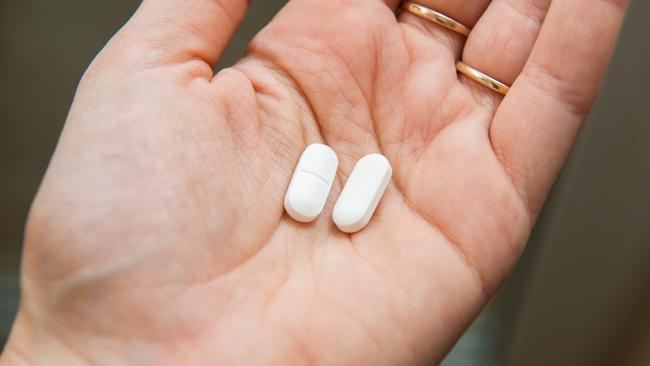What is Addison's disease? The life-threatening condition no one’s heard of
The signs can be easily missed by GPs

Lifestyle
Don't miss out on the headlines from Lifestyle. Followed categories will be added to My News.
Around 2500 Australians are living with a rare chronic condition often missed by doctors. So what is Addison's disease, and how can those suffering from it access treatment?
Last month, a rare disease led to the tragic death of a 25-year-old TikTok star. Her experience was eerily like mine.
In a TikTok posted on the 8th of August, Taylor Rousseau Grigg told her nearly 1.5 million followers that she hadn’t been feeling like herself in a long time.

In the nearly nine-minute video, Rousseau Grigg opened up about a recent struggle to maintain her trademark vibrance, feeling as though she was fighting for life each day. Having only recently received a diagnosis after suffering a steady health decline for almost 12 months, Rousseau Grigg chose not to disclose her exact diagnosis at the time, later adding in a comment that her current health struggles go some way in explaining the changes to her appearance.
But tragically, less than two months on from her video, a representative of the family shared with today.com that Rousseau Grigg had died from complications of asthma and Addison’s disease.
Watching her video, I was struck by the memory of my own reflection right before I was diagnosed with Addison’s disease.
At the time, my slender frame and heavily pigmented skin garnered compliments from those who didn’t realise I was fighting for life. Like Rousseau Grigg, I have both asthma and Addison’s disease, and like her, my Addison’s symptoms started soon after my wedding. I also had a tough time getting a diagnosis, and came close to death in the process.
According to Bronwyn Monro, President of the Australian Addison's Disease Association Incorporated (AADAI), when people with Addison’s symptoms present to the GP, it is common for the signs to be missed.
“It’s a rare disease,” she explains, “we call it the ‘diagnosis odyssey’ because for a number of people, it takes a very long time.”
For Monro, it was 14 months and a last-ditched presentation to the emergency department where she collapsed out of a wheelchair. For me, it was the middle of Melbourne lockdowns, at 16 weeks pregnant, unable to eat or stand up, with three specialists and a GP left scratching their heads.
If you’ve ever spoken to someone with Addison’s disease about their diagnosis, you’re likely to hear a pretty terrifying tale. For most people, the symptoms come on gradually, so it is common for diagnosis to occur only once the patient is in an ‘adrenal crisis’ – an immediately life-threatening emergency.

What is Addison’s disease?
According to the Cleveland Clinic, “Addison’s disease is a rare chronic condition in which your adrenal glands don’t produce enough of the hormones cortisol and aldosterone,” most commonly caused by autoimmune antibodies.
It is a rare disease, impacting only around 2500 Australians.
“Addison's Disease is the most common cause of ‘primary adrenal insufficiency’, or failure of the adrenal glands, but there can be other causes,” explains Monro who, at 76 has now been “living well with Addison’s” for more than 30 years. For example, surgery, cancer, and injury can all impact the adrenal glands causing them to stop functioning correctly.
Secondary adrenal insufficiency can also result from long-term or overuse of steroids, or because of certain cancer treatments, or other diseases impacting the function of the pituitary gland.
This is different to Addison’s in that the problem starts in the pituitary (in the brain), which is responsible for signalling the adrenals to produce cortisol and aldosterone.

Wait, aren’t we all trying to reduce cortisol?
With all the fuss about reducing cortisol on TikTok lately, you’d be forgiven for thinking that not producing enough could be a good thing. However, the Cleveland Clinic sums it up well when they say, “cortisol is essential for life.”
While it’s known colloquially as the ‘stress hormone’ cortisol is actually vital in helping your body cope with the stress of illness, injury, surgery and emotional distress. It also helps maintain blood pressure, heart function, immune system and blood glucose (sugar) levels.
Additionally, Aldosterone is responsible for managing electrolyte levels including sodium and potassium which work to balance blood pressure and blood volume.
So, yeah, pretty essential stuff!

What are the symptoms?
This is a bit of a sticky question, because not only will symptoms vary widely from person to person, but they also depend on whether that person is being adequately treated for the disease.
The below are some common signs that, when put together could be a strong indicator of undiagnosed adrenal insufficiency.
- A darkening of the skin overall, particularly noticeable around skin creases such as the knuckles, scars and on the gums
- Unexplained weight loss
- Crippling and worsening fatigue
- Gastrointestinal symptoms such as nausea, vomiting, pain and diarrhoea
- Muscular spasms
- Muscular pain and heaviness
- Dehydration
- Very low blood pressure
- Dizziness
- Brain fog, depression and agitation
- A strong craving for salty and/or sour foods
- Low blood sugar

What does treatment involve?
Once diagnosed, that laundry list of symptoms shouldn’t be a daily occurrence for those living with the disease.
While it’s true that Addison’s disease is lifelong, as there is no known cure once the antibodies begin attacking the adrenal glands, the good news for people like Monro and me, is that with some very careful considerations (and what sometimes feels like a pharmacy in our purses), those with Addison’s can live full, and fulfilling lives.
Treatment primarily involves replacing our missing hormones multiple times a day with a mix of corticosteroids.
Without getting too technical about it, a person with functioning adrenals will produce enough cortisol throughout the day to meet whatever their body demands. Those of us for whom the adrenals are simply ornamental, must use our best guess as to how much of the hormone our bodies will need that day.
For example, when I have one of my son’s seemingly endless daycare viruses, I will need to increase my daily steroid dose, and since there is no way to know for sure how much I need, I will likely be either a bit over or a bit under. This means sickness is a bigger deal for people like me, and without adequate replacement when sick or stressed, we run the risk of an adrenal crisis.

What is an adrenal crisis?
Glad you asked! Also known as an ‘Addisonian crisis’, an adrenal crisis is an immediately life-threatening absence of cortisol resulting in shock, seizures and coma, according to John’s Hopkins.
The AADAI website lists causes including:
- If an acute illness, infection, injury or medical procedure or surgery increases the body’s cortisol requirements.
- If doses are missed for longer than 24 hours.
- Prior to diagnosis of adrenal insufficiency, where a crisis may be the first presentation of the life-threatening condition.

What causes Addison’s disease?
This is the million-dollar question when it comes to autoimmune diseases, which are on the rise in Australia. They currently impact approximately 5 per cent of people, according to Monash University, with 75 per cent of cases impacting women.
The most common cause of Addison’s is an autoimmune malfunction, and though there is a lot we don’t know, we do know autoimmune diseases are often inherited, and can be triggered by major hormonal shifts including events like pregnancy and menopause. Certain viruses, infections or injury are also believed to contribute, though scientists are still working hard to pinpoint the causes.
So, what can be done?
I spoke to Monro from the ‘headquarters’ of the AADAI (also known as her kitchen table), where she works tirelessly to raise awareness and support those living with Addison’s.
She told me, “We want better education for GPs and for endocrinologists in how to treat us, and in how to pick up the disease - how to identify it.”

A big part of this involves a broader awareness of rare and chronic diseases within the general population. In her video detailing her health struggles, Rousseau Grigg initially chose not to share her precise diagnosis, citing a desire to protect herself from unsolicited advice or prescriptions from internet commenters when it comes to managing her health.
It’s a common experience for people with autoimmune diseases, invisible illness and disability to be dismissed or blamed for bringing on their conditions. I have personally heard everything from cutting out gluten, to trying transcendental meditation, to using positive thinking to encourage my body to stop attacking itself.
As a culture, we don’t cope very well with medical mystery. We prefer things to fit neatly into reason and when they don’t, we go looking for ways to explain away our fears.
But the more we dismiss rare diseases as something that can be cured with the right mix of herbal remedies and positive vibes, the more dangerous it can be for people living with them.
More Coverage
Originally published as What is Addison's disease? The life-threatening condition no one’s heard of




